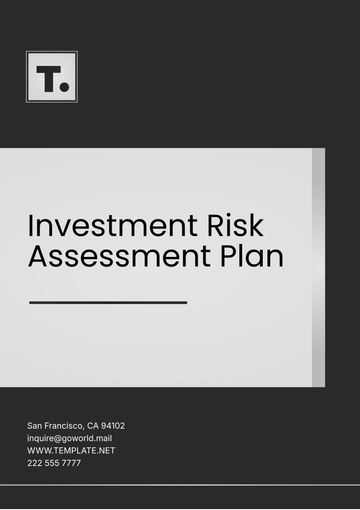Free Crypto Investment Plan

I. Executive Summary
Our Crypto Investment Plan is designed to strategically guide our investments within the cryptocurrency market, focusing on maximizing returns, managing risks, and achieving long-term financial growth. This plan outlines key components, including market analysis, asset allocation, and risk management strategies, tailored to navigate the volatility inherent in crypto assets. By balancing growth and income objectives, we aim to build a diversified portfolio that captures the value of established assets while allowing room for emerging technologies. Here are our goals:
Achieve an annual return of 20% over a five-year investment period.
Allocate 60% of assets to high-growth opportunities in leading cryptocurrencies.
Reserve 20% of assets in stablecoins for liquidity and risk management.
Generate an annual passive income yield of 8% through staking and lending activities.
II. Market Analysis
A. Crypto Market Overview
The cryptocurrency market has grown significantly in recent years, establishing itself as a viable asset class with diverse applications beyond speculative trading. Major cryptocurrencies have gained adoption in decentralized finance (DeFi), non-fungible tokens (NFTs), and cross-border transactions. This growth is expected to continue, albeit with potential regulatory fluctuations and high volatility. Given its relatively early stage, the crypto market provides unique opportunities for growth-driven investments alongside income-generating strategies.
B. Major Cryptocurrencies
Our portfolio will primarily focus on established cryptocurrencies that demonstrate stability, scalability, and a solid use case. Major cryptocurrencies like Bitcoin and Ethereum represent long-term value due to their adoption rates and network effects, while select altcoins offer growth potential through unique technical advantages and ecosystem support.
Cryptocurrency | Symbol | Market Position | Use Case |
|---|---|---|---|
Bitcoin | BTC | Leading asset | Store of value, digital gold |
Ethereum | ETH | Second largest | Smart contracts, DeFi |
Binance Coin | BNB | Exchange token | Exchange utility, DeFi |
Cardano | ADA | Smart contracts | Decentralized applications |
Solana | SOL | High-speed DeFi | DeFi, scalable applications |
C. Industry News and Influences
The cryptocurrency market is affected by a variety of external influences, including regulatory developments, technological advancements, and global economic conditions. For instance, regulatory stances from countries like the U.S. and China can significantly impact market stability. Additionally, innovations in blockchain interoperability, scalability, and DeFi contribute to adoption rates. Market trends such as institutional adoption and the integration of blockchain solutions by major financial firms also indicate a positive trajectory for cryptocurrencies as an asset class. Staying updated on these developments is essential for managing investments effectively and adapting to changing market conditions.
III. Investment Objectives
A. Primary Goals
Our primary goals are centered on capital appreciation, passive income generation, and maintaining a robust risk management approach. We aim to create a sustainable crypto portfolio that balances long-term growth with stable returns through strategic asset allocation and periodic rebalancing.
Achieve a 20% annualized return over a 5-year investment period.
Reserve 25% of the portfolio for income-generating assets like staking and lending.
Reduce exposure to highly volatile assets by maintaining 20% of holdings in stablecoins.
B. Targeted Asset Classes
The portfolio will consist of three primary asset classes: major cryptocurrencies (e.g., Bitcoin, Ethereum), promising altcoins with strong fundamentals, and stablecoins for liquidity management. Major cryptocurrencies will serve as the foundation, offering long-term growth and stability. Select altcoins with scalable solutions and unique utility will be included for growth potential, while stablecoins will provide a low-risk option for preserving capital during market downturns.
C. Income vs. Growth Balance
Our portfolio strategy seeks to balance income generation with growth. Approximately 60% of the portfolio will focus on high-growth assets, leveraging the appreciation potential of Bitcoin, Ethereum, and leading altcoins. Meanwhile, 25% will be allocated to yield-generating activities like staking and DeFi lending, generating consistent passive income and mitigating downside risk. This balanced approach allows us to benefit from market upswings while maintaining a steady income flow through yield-oriented investments.
IV. Asset Allocation Strategy
A. Portfolio Composition
Our portfolio composition is structured to balance growth and stability by allocating capital across major cryptocurrencies, promising altcoins, stablecoins, and income-generating assets. This diversified approach allows us to capture the potential upside of emerging technologies while managing downside risk. Our allocation is as follows:
Asset Class | Allocation (%) |
|---|---|
Major Cryptocurrencies (BTC, ETH) | 40% |
Altcoins (ADA, SOL, BNB) | 25% |
Stablecoins (USDC, USDT) | 20% |
Yield-Generating Assets (Staking, DeFi lending) | 15% |
B. Risk Classification
Each asset class is assigned a risk classification based on its volatility, market maturity, and historical performance. This classification enables us to manage overall portfolio risk and make informed allocation decisions.
Asset Class | Risk Level | Rationale |
|---|---|---|
Major Cryptocurrencies | Low-Medium | Established assets |
Altcoins | Medium-High | Higher volatility |
Stablecoins | Low | Useful for liquidity |
Yield-Generating Assets | Medium | Moderate income |
C. Diversification
Diversification is a key strategy to reduce risk and improve portfolio resilience. We diversify across various dimensions:
Asset Type: Allocating capital across major cryptocurrencies, altcoins, stablecoins, and yield-generating options.
Geographic Exposure: Selecting assets developed and primarily used in different regions to mitigate local regulatory risks.
Sector Exposure: Investing in assets that support DeFi, gaming, and other emerging blockchain sectors.
Liquidity: Balancing assets with high and low liquidity to ensure quick access to capital as needed.
D. Allocation Adjustments
Our portfolio will be rebalanced periodically based on market performance and evolving objectives. When asset values deviate by more than 5% from target allocations, adjustments will be made to bring the portfolio back in line. Additionally, we will consider seasonal or event-based adjustments in response to market cycles, regulatory changes, or industry developments.
V. Investment Strategies
A. Buy and Hold
The Buy and Hold strategy forms the foundation of our investment approach, particularly for major cryptocurrencies like Bitcoin and Ethereum. By holding these assets over a long term, we aim to benefit from their potential for appreciation while minimizing trading fees and reducing the need for constant market monitoring.
B. Dollar Cost Averaging (DCA)
We will implement Dollar Cost Averaging (DCA) by investing a fixed amount in select cryptocurrencies on a regular schedule (e.g., weekly or monthly). This approach reduces the impact of market volatility by spreading our purchases over time, helping us to acquire more assets at a lower average cost and mitigating the risk of buying at a market peak.
C. Yield Generation
To generate passive income, we will allocate a portion of our portfolio to yield-generating opportunities such as staking and DeFi lending. By staking coins like ETH or participating in lending pools within decentralized finance platforms, we aim to earn consistent returns that enhance overall portfolio performance, particularly during bearish market periods.
D. Speculative Trading
Speculative trading will focus on high-risk, high-reward opportunities in emerging or low-cap cryptocurrencies. These trades will be carefully selected based on market analysis, technical indicators, and sector trends. Due to their high volatility, speculative assets will represent a small portion of our portfolio and will be monitored closely.
Cryptocurrency | Symbol | Risk Level | Potential Reward |
|---|---|---|---|
Chainlink | LINK | High | Strong DeFi and oracle use case |
Polkadot | DOT | High | Scalability and interoperability |
Avalanche | AVAX | Very High | High-speed DeFi and dApp platform |
Cosmos | ATOM | High | Interconnected blockchain ecosystem |
E. Exit and Reentry Points
Our exit and reentry strategy allows us to take profits and reenter positions strategically to capitalize on market trends. We will monitor specific criteria to determine when to exit and reenter investments:
Profit Targets: Exit when assets reach pre-determined profit margins (e.g., 30%).
Market Sentiment: Exit in case of extreme bullishness or reenter during fear-based market dips.
Regulatory Changes: Exit positions if regulatory risks increase for a particular asset or market.
Fundamental Changes: Reevaluate positions if an asset undergoes significant technical or community updates that impact its potential.
VI. Risk Management
A. Risk Assessment
We recognize the inherent risks in cryptocurrency investments and actively manage them through risk assessment and mitigation strategies. Our assessment identifies key risks based on likelihood and potential impact, helping us prioritize areas that require close monitoring.
Risk | Likelihood | Impact |
|---|---|---|
Market Volatility | High | High |
Regulatory Changes | Medium | High |
Cybersecurity Threats | Medium | Medium |
Liquidity Risk | Medium | Medium |
Technology Risks | Low | Medium |
B. Stop-Loss Strategy
To manage downside risk, we employ stop-loss orders on certain high-volatility assets, ensuring that assets are automatically sold if they drop to a pre-set price threshold (e.g., a 15% decline from purchase price). This strategy allows us to minimize losses without needing to monitor market prices continuously, preserving capital in highly volatile environments.
C. Capital Protection Measures
Capital protection is a core element of our risk management strategy. We allocate 20% of our portfolio to stablecoins, which act as a buffer against market downturns and provide liquidity for reentry into the market when conditions improve. Additionally, we prioritize investments in established cryptocurrencies to ensure a foundational level of stability.
D. Insurance Options
We assess the potential of third-party insurance solutions to further protect our assets. Various options include:
Custodial Insurance: Coverage for assets held in third-party custodial wallets.
Smart Contract Insurance: Policies to protect against smart contract vulnerabilities in DeFi platforms.
Exchange Insurance: Insurance provided by exchanges to cover potential hacks or breaches.
VII. Tax and Legal Considerations
Cryptocurrency investments are subject to evolving tax and regulatory landscapes, especially in jurisdictions like the United States. We maintain compliance with all relevant tax laws and keep meticulous records of transactions for tax reporting purposes. Understanding applicable regulations also helps mitigate legal risks and ensures our investment strategy aligns with regulatory standards.
Internal Revenue Code, specifically IRS Notice 2014-21 (tax treatment of virtual currencies)
Securities Act of 1933 (potential securities classification for tokens)
Bank Secrecy Act (compliance with anti-money laundering regulations)
Commodity Exchange Act (potential classification of crypto as commodities by the CFTC)
VIII. Performance Tracking and Review
Performance tracking is essential for evaluating our investment strategy and ensuring alignment with our financial goals. We measure success using key performance indicators (KPIs), which help us track returns, yield, and risk-adjusted metrics.
Indicator | Target Value |
|---|---|
Annualized ROI | 20% |
Yield from Staking/Lending | 8% |
Portfolio Volatility | Under 25% |
Asset Allocation Deviance | Within 5% of targets |
We conduct quarterly reviews of our portfolio to assess performance, make rebalancing adjustments, and revise strategies as necessary. Annual reviews provide a deeper assessment to ensure long-term goals are on track.
IX. Exit Strategy
A. Profit Taking Plan
Our profit-taking plan involves selling assets incrementally as they reach pre-set profit targets (e.g., a 30% increase from purchase price). By locking in gains over time, we reduce the risk of sudden downturns affecting overall returns. This gradual approach helps maintain exposure to growth while securing profits.
B. Long Term Holdings
For select major assets like Bitcoin and Ethereum, we maintain long-term holdings that align with a buy-and-hold strategy. These assets are held in cold storage to ensure security and will only be reconsidered for sale if they experience significant, sustained market changes.
C. Emergency Liquidation Plan
In the event of severe market disruptions or personal financial needs, we have an emergency liquidation plan to swiftly liquidate a portion of our holdings. Priority will be given to assets with the highest liquidity, ensuring a fast and effective liquidation process without impacting the broader portfolio significantly.
D. Final Withdrawal Plan
Our final withdrawal plan outlines the process for exiting the market in line with our financial objectives, whether for retirement or a major expense. Assets will be liquidated in stages to minimize the tax impact, with stablecoins acting as a buffer for smoother fund withdrawals.
X. Glossary
Altcoin: Any cryptocurrency other than Bitcoin.
Asset Allocation: Distribution of investments across various asset types.
Cold Storage: Offline storage method for cryptocurrency, enhancing security.
DeFi (Decentralized Finance): Financial applications built on blockchain technology.
Dollar-Cost Averaging (DCA): Investing fixed amounts at regular intervals to reduce the impact of volatility.
Exit Strategy: Plan for selling assets to realize profits or limit losses.
Liquidity Risk: The risk that an asset cannot be sold quickly without affecting its price.
Market Volatility: The degree of variation in the price of an asset over time.
Portfolio Rebalancing: Adjusting the weightings of assets in a portfolio to maintain a target allocation.
Risk Tolerance: An investor's ability and willingness to withstand losses in their investment value.
Stablecoin: A type of cryptocurrency pegged to a stable asset, like the U.S. dollar.
Staking: Locking up cryptocurrency to support network operations and earn rewards.
Stop-Loss Order: An automatic order to sell an asset once it reaches a certain price.
Crypto Templates @ Template.net
- 100% Customizable, free editor
- Access 1 Million+ Templates, photo’s & graphics
- Download or share as a template
- Click and replace photos, graphics, text, backgrounds
- Resize, crop, AI write & more
- Access advanced editor
Develop a strong strategy with Template.net’s Crypto Investment Plan Template, an editable and customizable tool for planning cryptocurrency investments. Fully editable in our AI Editor tool, this template allows you to personalize goals, timelines, and risk assessments, making it easy to create a comprehensive and professional investment plan that aligns with your financial objectives.
You may also like
- Finance Plan
- Construction Plan
- Sales Plan
- Development Plan
- Career Plan
- Budget Plan
- HR Plan
- Education Plan
- Transition Plan
- Work Plan
- Training Plan
- Communication Plan
- Operation Plan
- Health And Safety Plan
- Strategy Plan
- Professional Development Plan
- Advertising Plan
- Risk Management Plan
- Restaurant Plan
- School Plan
- Nursing Home Patient Care Plan
- Nursing Care Plan
- Plan Event
- Startup Plan
- Social Media Plan
- Staffing Plan
- Annual Plan
- Content Plan
- Payment Plan
- Implementation Plan
- Hotel Plan
- Workout Plan
- Accounting Plan
- Campaign Plan
- Essay Plan
- 30 60 90 Day Plan
- Research Plan
- Recruitment Plan
- 90 Day Plan
- Quarterly Plan
- Emergency Plan
- 5 Year Plan
- Gym Plan
- Personal Plan
- IT and Software Plan
- Treatment Plan
- Real Estate Plan
- Law Firm Plan
- Healthcare Plan
- Improvement Plan
- Media Plan
- 5 Year Business Plan
- Learning Plan
- Marketing Campaign Plan
- Travel Agency Plan
- Cleaning Services Plan
- Interior Design Plan
- Performance Plan
- PR Plan
- Birth Plan
- Life Plan
- SEO Plan
- Disaster Recovery Plan
- Continuity Plan
- Launch Plan
- Legal Plan
- Behavior Plan
- Performance Improvement Plan
- Salon Plan
- Security Plan
- Security Management Plan
- Employee Development Plan
- Quality Plan
- Service Improvement Plan
- Growth Plan
- Incident Response Plan
- Basketball Plan
- Emergency Action Plan
- Product Launch Plan
- Spa Plan
- Employee Training Plan
- Data Analysis Plan
- Employee Action Plan
- Territory Plan
- Audit Plan
- Classroom Plan
- Activity Plan
- Parenting Plan
- Care Plan
- Project Execution Plan
- Exercise Plan
- Internship Plan
- Software Development Plan
- Continuous Improvement Plan
- Leave Plan
- 90 Day Sales Plan
- Advertising Agency Plan
- Employee Transition Plan
- Smart Action Plan
- Workplace Safety Plan
- Behavior Change Plan
- Contingency Plan
- Continuity of Operations Plan
- Health Plan
- Quality Control Plan
- Self Plan
- Sports Development Plan
- Change Management Plan
- Ecommerce Plan
- Personal Financial Plan
- Process Improvement Plan
- 30-60-90 Day Sales Plan
- Crisis Management Plan
- Engagement Plan
- Execution Plan
- Pandemic Plan
- Quality Assurance Plan
- Service Continuity Plan
- Agile Project Plan
- Fundraising Plan
- Job Transition Plan
- Asset Maintenance Plan
- Maintenance Plan
- Software Test Plan
- Staff Training and Development Plan
- 3 Year Plan
- Brand Activation Plan
- Release Plan
- Resource Plan
- Risk Mitigation Plan
- Teacher Plan
- 30 60 90 Day Plan for New Manager
- Food Safety Plan
- Food Truck Plan
- Hiring Plan
- Quality Management Plan
- Wellness Plan
- Behavior Intervention Plan
- Bonus Plan
- Investment Plan
- Maternity Leave Plan
- Pandemic Response Plan
- Succession Planning
- Coaching Plan
- Configuration Management Plan
- Remote Work Plan
- Self Care Plan
- Teaching Plan
- 100-Day Plan
- HACCP Plan
- Student Plan
- Sustainability Plan
- 30 60 90 Day Plan for Interview
- Access Plan
- Site Specific Safety Plan





























